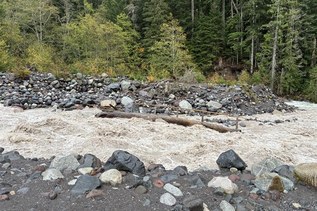Camp Muir represents a dividing line: this is as high as you can go on Mount Rainier without a climbing permit. From here, you get a close-up view that few visitors to the park ever see: hanging glaciers, towering seracs, yawning crevasses and thundering rockfall as the ridges of ash and breccia high above melt and crumble in the heat of the sun.
For most hikers, this glimpse into the high alpine is reward enough, but for some, the lure of the dramatic landscape lying just beyond proves too tempting, and Camp Muir turns from a dividing line into a jumping off point for dreams of the summit.
The route begins at Paradise and is typically under snow for its entire length until August. When not in snow, the first 2 miles travel first over paved trails and then over rocky paths through subalpine meadows. Used as a golf course in the 1930s and then as a ski area until the 1970s, the meadows have been under restoration for the last 3 decades and likely will be for the indefinite future — a testament to the fragile ecosystem that exists at this already high altitude. In this early section, it is not uncommon to see marmots and deer, as well as the occasional ptarmigan, fox or even bear.
From the stairs behind the visitors center, follow the Skyline Trail past Glacier Vista and through a hairpin switchback. Shortly thereafter, turn left along a small creek — a sign points to Pebble Creek and Camp Muir. At roughly 2 miles, pass through the Pebble Creek drainage. This rocky gully is your last source of water, short of melting snow. In the soft light of dusk or dawn, it is an enchanting spot, filled with the gentle sound of Pebble Creek spilling over the plate-like rocks.
Even in late summer, the trail is snow-covered upon reaching the Muir Snowfield. It is here that the real climb begins. The snowfield undulates, at first quite steeply, over mounded snow. Mount Adams, Mount St. Helens and Mount Hood come rapidly into view above the Tatoosh Range to the south. The terrain flattens out somewhat above 8,000 feet, but offers little relief as the air grows noticeably thinner. Camp Muir comes into view around 9,000 feet. It looks so close, yet seems to grow no closer — the last 250 vertical feet, marked by a rocky ridge to your right, feel interminable, even for strong climbers.
As you reach the respite of Camp Muir, gaze out across the Cowlitz Glacier to the towering mass of Gibraltar Rock, the steep walls of Cathedral Rock, and Little Tahoma, which seems dwarfed by the other features, despite being the third highest peak in the state. A small tent city populated by climbers headed to the summit stretches out onto the glacier.
Two stone structures at either end of the saddle — one a guide hut, one a public shelter for climbers — are every bit as old as they look, having stood here for nearly a century. Camp Muir’s history stretches back even further — once known as "Cloud Camp," it was renamed for naturalist John Muir after his ascent to the summit in 1888. During his party’s climb, he suggested it as a good spot to camp in the mistaken belief that it would provide shelter from the wind. Following his visit, Muir went on to play a major role in the campaign to establish Mount Rainier as a national park.
WTA Pro Tip: The way down is often more treacherous than the way up. In good weather, the snow will have warmed to the consistency of soft ice cream. In bad weather, it can be easy to lose your way — the natural tendency is to follow the slope of the hill to the right and onto the heavily crevassed Nisqually Glacier. Bring a GPS device or download compass bearings from the park website as a backup.
Such contingencies show that the dividing line between day hiking and alpine conditions is blurred here, yet another way this hike takes you into truly rarefied air, more than halfway up the tallest peak in Washington.






 Trailhead
Trailhead



